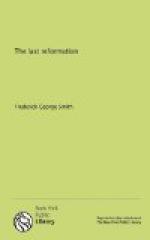Other writers of the period under consideration, however, praise the saving efficacy of baptism in the most exalted terms. According to their minds, it is the actual means of the redemption of sins, not a mere literal rite expressing ceremonially the work of God’s Spirit within the heart; it is an illumination; it extinguishes the fire of sin; it removes the unclean spirits from men and seals them for heaven. Tertullian wrote extensively on this subject. In his work On Baptism, chapters 3 to 8, he maintains the doctrine of baptismal regeneration “by which we are washed from the sins of our former blindness and set free for eternal life.” He declares that by this act men are prepared to receive the Holy Ghost; that in the literal act, “the spirit is corporeally washed in the waters, and the flesh is, in the same, spiritually cleansed.” Cyprian, bishop of Carthage (third century), in his treatise concerning the Baptism of Heretics, teaches the same doctrine in no uncertain terms.
[Sidenote: Other erroneous doctrines and practises]
The limits of this work preclude the historic treatment of the rise and development of the host of false doctrines and practises that finally bound the people in the thralldom of superstition and plunged the world into the darkness of spiritual night. One who is free from such influences can scarcely read without feelings of disgust the elaborate treatises of these church fathers wherein they extol the virtues of virginity as forming a new order of life, as an evidence of divinity, as making virgins while in this world “equal to the angels of God,” and as a certain surety of special rewards in heaven. From this false standard proceeded at length the celibacy of the clergy and monkery with all their attendant evils. And the time would fail me to tell of the introduction of images and image-worship in the Western Church and of that superstitious regard for miserable relics of every description and kind. True evangelical faith was at length lost to view, buried beneath the rubbish of men’s traditions. The treatment of such matters, however, belongs to the church historian, and as the general facts are well-known, it is unnecessary here to make more than a brief reference to them so as to prepare the mind for that treatment of the reformation which is a special object of the present work.
[Footnote A: Tertullian is the earliest writer that clearly and unmistakably teaches trine immersion, or records its practise. But here he honestly confesses that it is a “somewhat ampler pledge than the Lord has appointed in the gospel.”]
CHAPTER VI
RISE OF ECCLESIASTICISM
[Sidenote: Two phases of apostacy]




